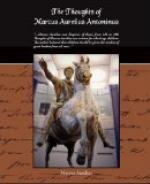Antoninus and his son Commodus entered Rome in triumph, perhaps for some German victories, on the 23d. of December, A.D. 176. In the following year Commodus was associated with his father in the empire, and took the name of Augustus. This year A.D. 177 is memorable in ecclesiastical history. Attalus and others were put to death at Lyon for their adherence to the Christian religion. The evidence of this persecution is a letter preserved by Eusebius (E.H. V. I; printed in Routh’s Reliquiae Sacrae, vol. i, with notes). The letter is from the Christians of Vienna and Lugdunum in Gallia (Vienna and Lyon) to their Christian brethren in Asia and Phrygia; and it is preserved perhaps nearly entire. It contains a very particular description of the tortures inflicted on the Christians in Gallia, and it states that while the persecution was going on, Attalus, a Christian and a Roman citizen, was loudly demanded by the populace and brought into the amphitheatre; but the governor ordered him to be reserved, with the rest who were in prison, until he had received instructions from the emperor. Many had been tortured before the governor thought of applying to Antoninus. The imperial rescript, says the letter, was that the Christians should be punished, but if they would deny their faith, they must be released. On this the work began again. The Christians who were Roman citizens were beheaded; the rest were exposed to the wild beasts in the amphitheatre. Some modern writers on ecclesiastical history, when they use this letter, say nothing of the wonderful stories of the martyrs’ sufferings. Sanctus, as the letter says, was burnt with plates of hot iron till his body was one sore and had lost all human form; but on being put to the rack he recovered his former appearance under the torture, which was thus a cure instead of a punishment. He was afterwards torn by beasts, and placed on an iron chair and roasted. He died at last.
The letter is one piece of evidence. The writer, whoever he was that wrote in the name of the Gallic Christians, is our evidence both for the ordinary and the extraordinary circumstances of the story, and we cannot accept his evidence for one part and reject the other. We often receive small evidence as a proof of a thing we believe to be within the limits of probability or possibility, and we reject exactly the same evidence, when the thing to which it refers appears very improbable or impossible. But this is a false method of inquiry, though it is followed by some modern writers, who select what they like from a story and reject the rest of the evidence; or if they do not reject it, they dishonestly suppress it. A man can only act consistently by accepting all this letter or rejecting it all, and we cannot blame him for either. But he who rejects it may still admit that such a letter may be founded on real facts; and he would make this admission as the most probable way of accounting for the existence of the letter; but if, as he would suppose, the writer has stated some things falsely, he cannot tell what part of his story is worthy of credit.




